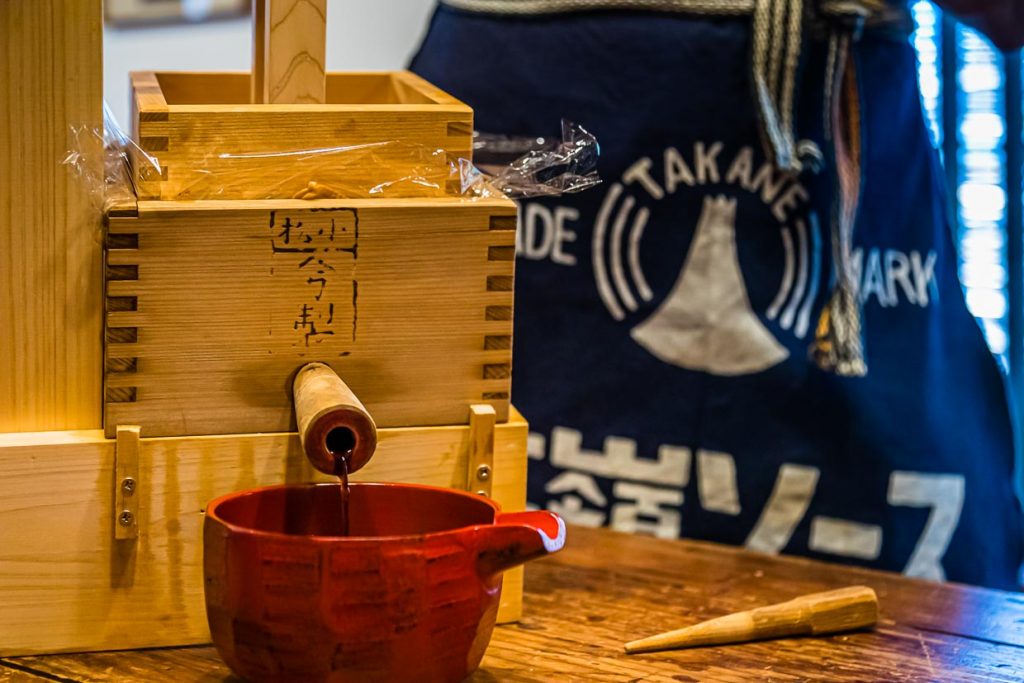Soy sauce is an indispensable seasoning in Japanese cuisine. A small manufactory in Shizuoka Prefecture has made it its business to pass on the traditional knowledge of the classic production of soy sauce to younger generations. But food-loving tourists can also enjoy a tour of the old Mejiiya Shoyu manufactory dating from 1872 near Hamamatsu. Shohei Nozue, who runs the company together with his wife in the sixth generation, has come up with a combination of a production tour and a workshop. Shohei has given the old craft tradition a modern marketing twist. Visitors have the final steps of Moromi on the way to a spicy soy sauce in their own hands.
Few ingredients for an intense flavor

A visit to the Mejiiya Shoyu manufactory is worth seeing for the old production facility alone. Japanese wooden houses are not so common anymore. Many old buildings have been destroyed by earthquakes or fire, or demolished for lack of space and replaced by efficient new construction. The soybean factory is laid out on three levels. As a visitor, you first climb up a ladder to get a glimpse into the huge cedar barrels. They hold moromi, a viscous mass of cooked soybeans, roasted wheat and salt. Like so many good foods, soy sauce is based on the principle of fermentation. This is because the cooked soybeans have been inoculated with a fungus called tanekoji. For three days, the fungus sprouts on the soybeans before the few ingredients of soybeans, water, salt and wheat are brought together in a cedar barrel. The fungus now begins its work, splitting soybeans and wheat into amino acids. Completely new complex flavors are created. The addition of wheat distinguishes the Japanese version of soy sauce. The brewing process is also longer than for the original Chinese version of the condiment.

Similar to the production of miso, the components time and temperature are crucial for the production process. In the warm summer, the mold is more active and the moromi is stirred with a large paddle every seven days. In winter, the process is slower and stirring is sufficient every 14 days. Fermentation and time, Shohei Nozue is certain, are the most important components for a high-quality soy sauce. In “brewed” soy sauce, fermentation also produces natural glutamate, making the dark seasoning a natural flavor enhancer.

Taru, as the large cedar barrels are called. On the lower floor of the three-story manufactory, the scale of the wooden giants really becomes clear to the visitor. Moromi, fermented here depending on the quality, between 1.5 to 3 years. Handcrafted using traditional fermentation, soy sauce tastes different from year to year and from barrel to barrel. In industrial production, as is often the case, time is a scarce and expensive commodity. Additives are added to speed up the process.

Getting down to business – making soy sauce yourself
After the guided tour through the old main building of the manufactory, it’s literally time to “get down to business”. Matured Moromi is presented to the workshop participants in a small bucket. What happens in the manufactory with 1,000 liters of the mash now takes place on a small scale. Moromi is pressed through several layers of cloth. Through the filter pressing, 800 liters of soy sauce come out in the end. The workshop version also requires a lot of physical effort. The small wooden presses require real physical effort.



It’s a great feeling when, after some jerking and pressing, Shoju master Shohei Nozue gives the signal to pull the stopper and let the freshly pressed soy sauce flow into a porcelain bowl. To stop the fermentation process, the soy sauce is still heated over a Bunsen burner and then poured into sterile bottles. This creates a bottle of soy sauce for each participant to take home.


It takes about 570 days for the soybean and roasted wheat to become a finished soy sauce. At the end of the workshop, 100 ml of self-pressed soy happiness stands in front of you in a jar – there is no better souvenir of a trip to Japan.



Another Japanese specialty, on which you can also practice using soy sauce right away, is gyoza. Hamamatsu is considered the capital for gyoza in Japan. There are about 300 gyoza restaurants in the city alone. The dumplings are filled with minced pork, white cabbage, scallions, garlic and ginger and are traditionally served in Hamamatsu decorated in a circle. The simple dish is especially popular among the working population. Japanese work long and hard, often lacking the time to cook. That’s where gyoza restaurants come in handy. As a snack during the lunch break or as a take-away for dinner at home. A visit to one of the simple eateries, somewhat reminiscent of American diners, is highly recommended.

There are about 300 gyoza restaurants in Hamamatsu, Shizuoka Prefecture. We visited the Ishimatsu Gyoza.
More information on food experiences in Shizuoka Prefecture.
More about the Mejiiya Shoyu Manufactory in Hamamatsu and a visit to a workshop at the Soy Sauce Factory.
The stay in the prefecture was partly supported by the Shizuoka Tourism Association

